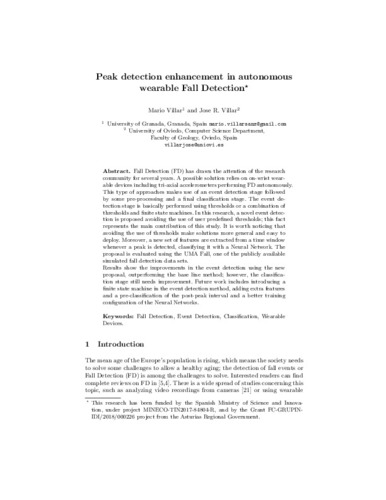Peak detection enhancement in autonomous wearable Fall Detection
Autor(es) y otros:
Palabra(s) clave:
Fall detection
Event Detection
Classification
Wearable devices
Fecha de publicación:
Versión del editor:
Serie:
Intelligent Systems Design and Applications, 1181
Descripción física:
Resumen:
Fall Detection (FD) has drawn the attention of the research community for several years. A possible solution relies on on-wrist wear- able devices including tri-axial accelerometers performing FD autonomously. This type of approaches makes use of an event detection stage followed by some pre-processing and a final classification stage. The event de- tection stage is basically performed using thresholds or a combination of thresholds and finite state machines. In this research, a novel event detec- tion is proposed avoiding the use of user predefined thresholds; this fact represents the main contribution of this study. It is worth noticing that avoiding the use of thresholds make solutions more general and easy to deploy. Moreover, a new set of features are extracted from a time window whenever a peak is detected, classifying it with a Neural Network. The proposal is evaluated using the UMA Fall, one of the publicly available simulated fall detection data sets. Results show the improvements in the event detection using the new proposal, outperforming the base line method; however, the classifica- tion stage still needs improvement. Future work includes introducing a finite state machine in the event detection method, adding extra features and a pre-classification of the post-peak interval and a better training configuration of the Neural Networks.
Fall Detection (FD) has drawn the attention of the research community for several years. A possible solution relies on on-wrist wear- able devices including tri-axial accelerometers performing FD autonomously. This type of approaches makes use of an event detection stage followed by some pre-processing and a final classification stage. The event de- tection stage is basically performed using thresholds or a combination of thresholds and finite state machines. In this research, a novel event detec- tion is proposed avoiding the use of user predefined thresholds; this fact represents the main contribution of this study. It is worth noticing that avoiding the use of thresholds make solutions more general and easy to deploy. Moreover, a new set of features are extracted from a time window whenever a peak is detected, classifying it with a Neural Network. The proposal is evaluated using the UMA Fall, one of the publicly available simulated fall detection data sets. Results show the improvements in the event detection using the new proposal, outperforming the base line method; however, the classifica- tion stage still needs improvement. Future work includes introducing a finite state machine in the event detection method, adding extra features and a pre-classification of the post-peak interval and a better training configuration of the Neural Networks.
Descripción:
International Conference on Intelligent Systems Design and Applications (ISDA) (19th. 2019. Online)
ISBN:
Patrocinado por:
This research has been funded by the Spanish Ministry of Science and Innovation, under project MINECO-TIN2017-84804-R, and by the Grant FC-GRUPINIDI/2018/000226 project from the Asturias Regional Government.
Colecciones
- Informática [875]
- Investigaciones y Documentos OpenAIRE [8416]
- Ponencias, Discursos y Conferencias [4231]
Ficheros en el ítem




